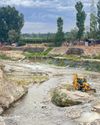
NASA’s last mission to Venus, Magellan, ended in 1994. What renewed your interest in the planet after 27 years?
The Venus missions had been proposed primarily for NASA's New Frontiers programme, and then for Discovery, but they did not get picked. This is not because there wasn’t a desire to go back to Venus, it’s just that other proposals—for example, the Juno mission to Jupiter or the Osiris Rex, Lucy and Psyche missions aimed for asteroids—beat them. Venus was also not as big a priority as Mars, where people were eager to detect signs of life.
However, between Magellan and now, there has been amazing technological development. Radars are more sophisticated, as are the radiometers that will map the composition of Venus’s surface and measure the light it emits into space. The chemical instrumentation to measure the composition of the atmosphere is phenomenal; we can now measure components that are present in minute amounts, like noble gases, which are important in understanding the history of the atmosphere. This is why we picked missions to Venus now.
What scientific return do you expect from DAVINCI+ and VERITAS?
The missions we pick face strict competition. The process began two years ago; we had 18 proposals and we evaluated their science and implementation plans. We then narrowed them down to four. These teams then planned their missions at an even higher level of detail. We looked at their implementability, cost, NASA's budget, among other things. So while evaluating their scientific return, we do not just consider the science, but also how it would fit with our portfolio. Right now, we do not have other missions to Venus; we are also going to launch the James Webb Space Telescope to study exoplanets [planets that exist outside the solar system] soon. These missions would help with that.
Denne historien er fra June 16, 2021-utgaven av Down To Earth.
Start din 7-dagers gratis prøveperiode på Magzter GOLD for å få tilgang til tusenvis av utvalgte premiumhistorier og 9000+ magasiner og aviser.
Allerede abonnent ? Logg på
Denne historien er fra June 16, 2021-utgaven av Down To Earth.
Start din 7-dagers gratis prøveperiode på Magzter GOLD for å få tilgang til tusenvis av utvalgte premiumhistorier og 9000+ magasiner og aviser.
Allerede abonnent? Logg på

In leading role again
MOVIES AND WEB SERIES ARE ONCE AGAIN BEING SET IN RUSTIC BACKGROUNDS, INDICATING A RECONNECT BETWEEN CINEMA AND THE COUNTRYSIDE

One Nation One Subscription comes at a huge cost
As top US universities scrap big deals with top scientific publishers, India’s ONOS scheme seems flawed and outdated

Return of Rambhog
Bid to revive and sell the aromatic indigenous paddy variety has led to substantial profits for farmers in Uttar Pradesh's Terai region

Scarred by mining
Natural springs of Kashmir drying up due to illegal riverbed mining

Human-to-human spread a mutation away
CANADA IN mid-November confirmed its first human case of avian influenza, with a teenager in the British Columbia being hospitalised after contracting the H5N1 virus that causes the disease. The patient developed a severe form of the disease, also called bird flu, and had respiratory issues. There was no known cause of transmission.

True rehabilitation
Residents of Madhya Pradesh's Kakdi village take relocation as an opportunity to undertake afforestation, develop sustainable practices

INESCAPABLE THREAT
Chemical pollution is the most underrated and underreported risk of the 21st century that threatens all species and regions

THAT NIGHT, 40 YEARS AGO
Bhopal gas disaster is a tragedy that people continue to face

A JOKE, INDEED
A CONFERENCE OF IRRESPONSIBLE PARTIES THAT CREATED AN OPTICAL ILLUSION TO THE REALITY OF A NEW CLIMATE

THINGS FALL APART
THE WORLD HAS MADE PROGRESS IN MITIGATING EMISSIONS AND ADAPTING TO CLIMATE IMPACTS. BUT THE PROGRESS REMAINS GROSSLY INADEQUATE